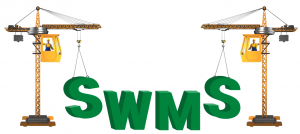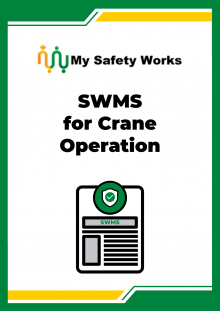Description
About this SWMS for Crane Operation
Safe crane operation is critical to ensure the safety of workers and the efficiency of operations. This SWMS covers the risks, hazards and controls associated with undertaking work that involves the operation of crane. The SWMS provides the necessary safety control measures to help ensure that crane operations are performed safely and effectively.

Job steps that are covered in the safe work method statement include:
- Planning and preparation.
- Crane pre-operational tasks.
- General crane operation.
- Fitting attachments.
- Crane interacting with workers.
- Lifting of workboxes, or personnel safety cages.
- Re-fuelling.
- Cleaning area and packing up equipment.
- Emergency rescue.
This SWMS includes:
- A risk assessment and risk assessment matrix.
- Qualifications and training requirements.
- Potential hazards and risks when operating and working near a crane.
- Control measures, checks and monitoring activities.
- Actions for implementation, monitoring and reviewing of the SWMS.
- Personal protective equipment (PPE)
- Inspections and maintenance checks that are required.
- Responsibilities.
- A consultation and sign-off record.
- Legislation references.
Crane Safety and Lifting Operations
Crane work and lifting operations can present very high risks to persons involved in the task and other persons in the work area. Assessing and controlling the risks and having qualified and competent personnel using the correct equipment in a safe manner is a key requirement (and legal obligation) for safe crane lifting operations.
Note: Legislation applicable to crane work is comprehensive. It is extremely important that all applicable sections of the WHS Regulation, Codes of Practice and relevant Australian Standards are reviewed and discussed in as much depth as is necessary to effectively manage the work safely.
Before any crane, lifting or rigging work commences, the following safety precautions should be undertaken:
- Operators, riggers and doggers must hold the appropriate high-risk work (HRW) license and be deemed competent for the tasks.
- The crane must be up to date with all servicing and maintenance requirements (CraneSafe inspections, etc.).
- All lifting equipment (chains, shackles, slings, wire ropes, etc.) must be inspected and verified as safe to use by a competent person.
- The ground or supporting structure must be verified as suitable for the weight and movement of the crane and loads.
- Working distances to overhead or nearby structures need to be verified as safe.
- Safe working distances to any powerlines need to be verified with legislative exclusions zones.
- The necessary barricading to delineate the work area (including slew radius) needs to be established and signage erected to advise and exclude unauthorised personnel.
- Communication methods to be used by the crane crew need to be verified.
- Other personnel onsite must receive the necessary information to enable them to conduct their work safely or remove them from the work area if necessary.
- Depending on whether the lift has been designated as high-risk or critical, it may be necessary to complete a lift plan/lift study.
- Assess if the weather will have a negative impact on the lift and determine what conditions would render the lift unsafe.
- Crane operations must stop if the wind speed is more than the recommended speed specified on the load chart and the configuration being used.
- It should be noted when doing risk assessments that ‘generally’ the safe operation of a crane becomes difficult to ensure when the wind speed exceeds 36 km/hour, irrespective of the size of the load. However, in many situations, this speed may be excessive, particularly where the load and boom have large surface areas.
- All lifts must comply with the crane’s load chart—no exceptions.
- Lifts are not to be undertaken unless the essential counterweight has been positioned on the crane to balance the load.
- Ensure tag lines are available when manoeuvring a load into a position as loads must not be permitted to swing over people or into structures.
- Ensure all personnel involved in the crane work and lifting operations have been consulted on the safe work method statement, lift plan and understand all the safety procedures.
Why Choose to Buy this SWMS for Crane Operation?
- Crane operation can be very hazardous and requires the utmost of safety precautions.
- This SWMS can assist you facilitate the safe operation of a crane and the reduction, as far as reasonably practicable of all hazardous interactions.
- The SWMS can assist you with the essential safety control measures for crane operators and ground personnel, to ensure a safe working environment at a construction site.
After purchasing this SWMS for crane operation you will be able to:
- Very easily edit and customize the template to create your own crane SWMS.
- Apply your own style, format and brand to the safe work method statement.
- Enable compliance with Australian legislation, codes of practice and standards.
Availability and Use of this SWMS for Crane Operation
- This SWMS is accessible to you right now by clicking the ‘Buy Now’ button.
- The SWMS will be delivered to you in fully editable Microsoft Word format for immediate and full use in your business.
- There are no subscriptions, contracts or ongoing costs.

This SWMS is 100% satisfaction guaranteed.
You may also require:


